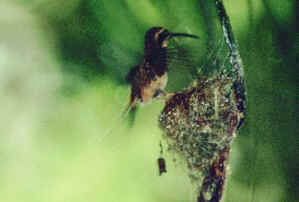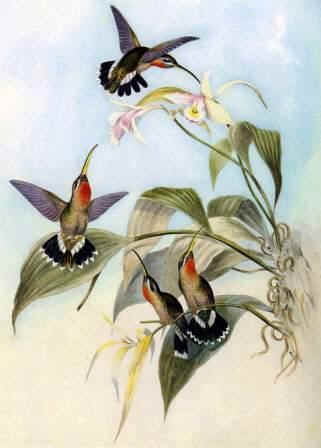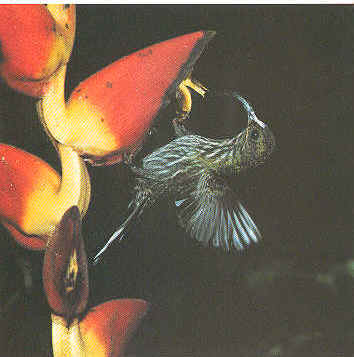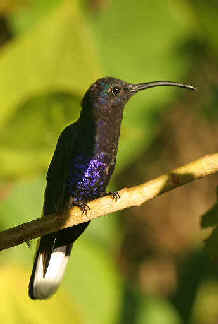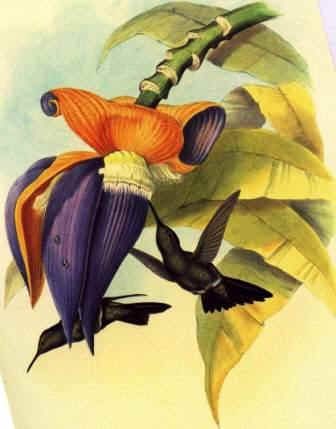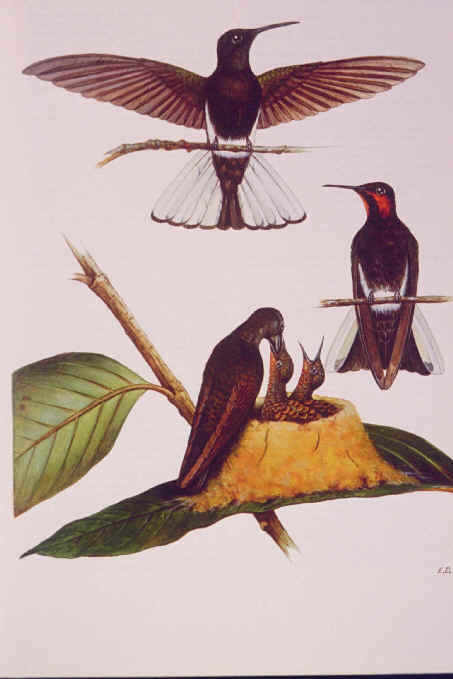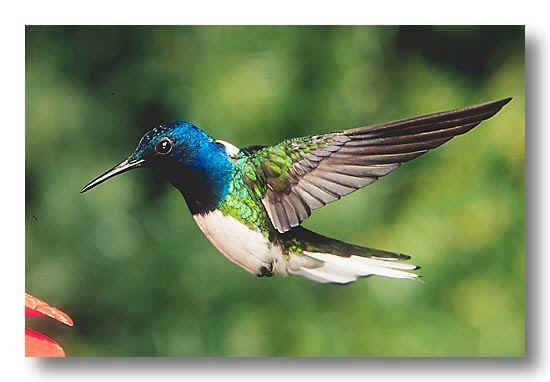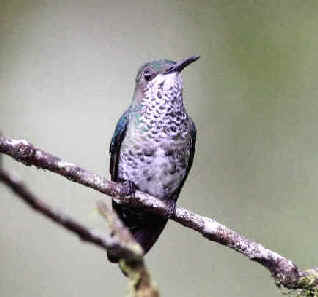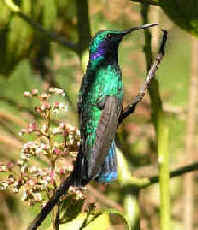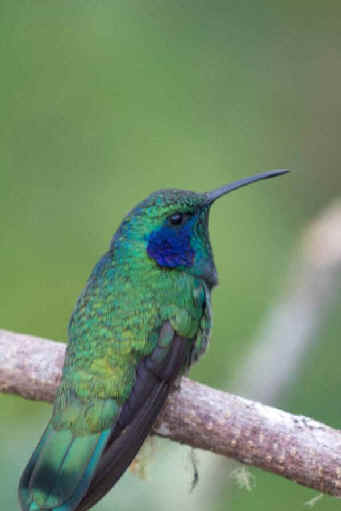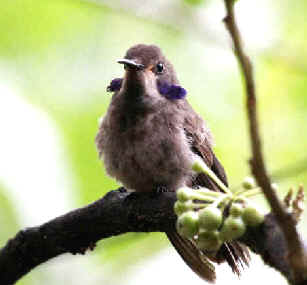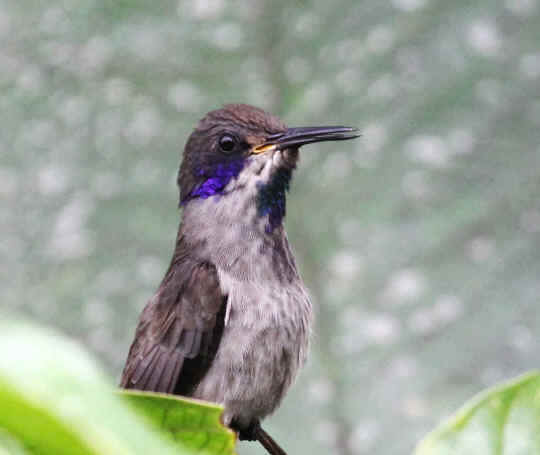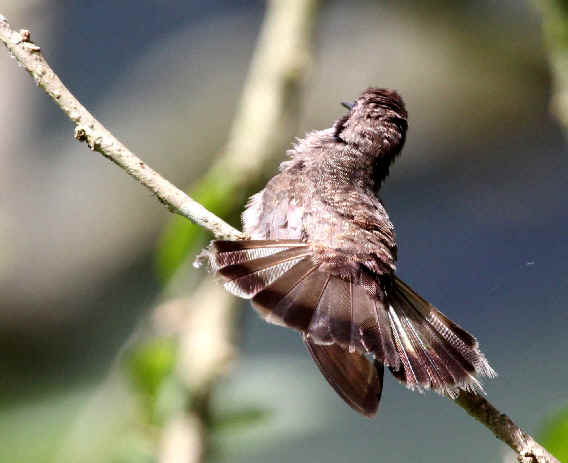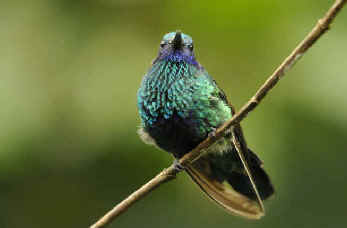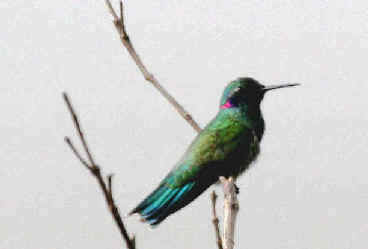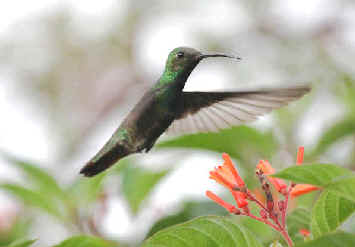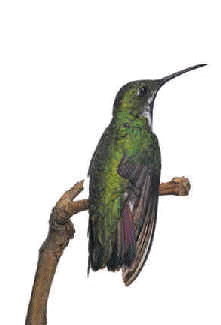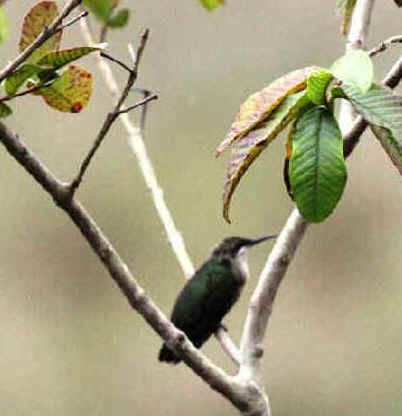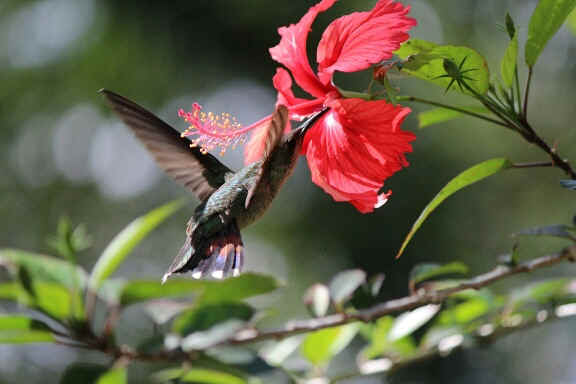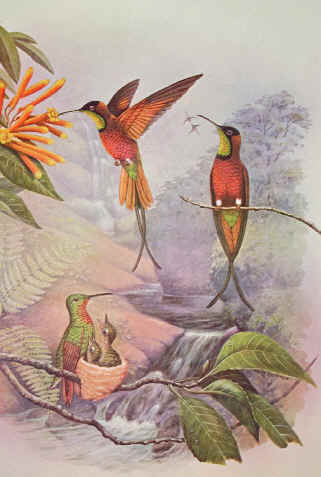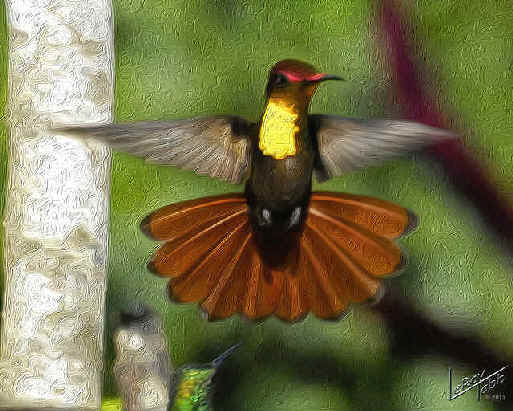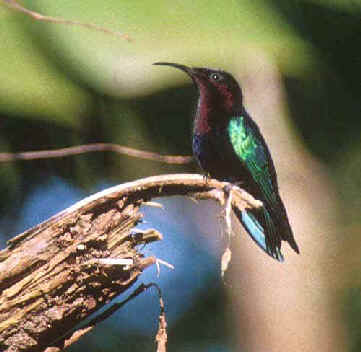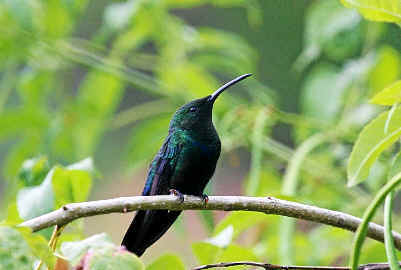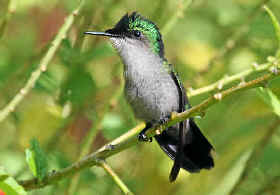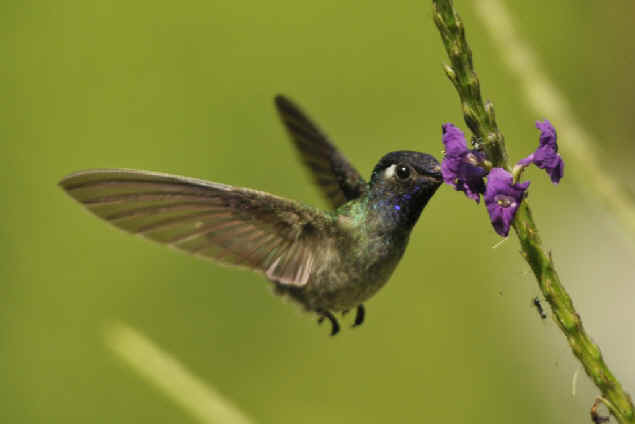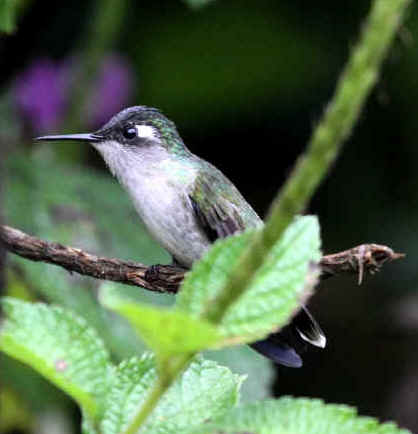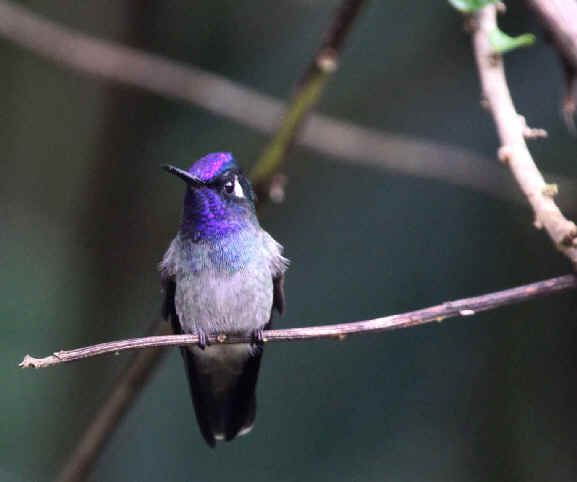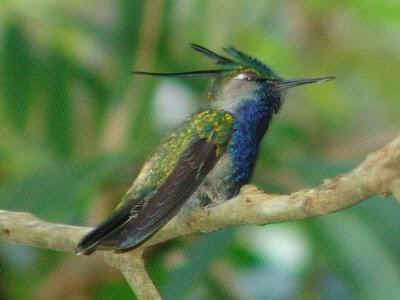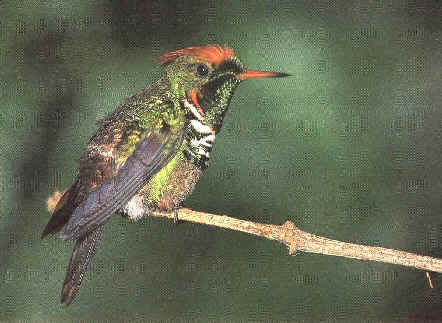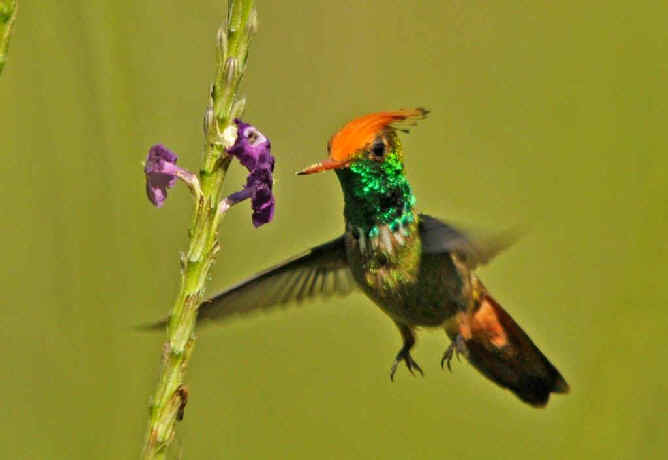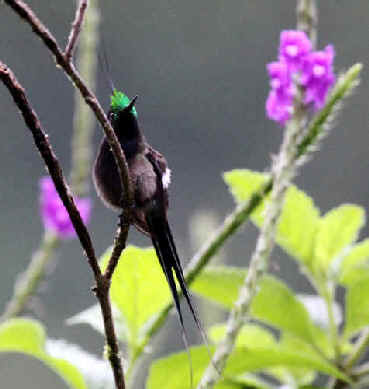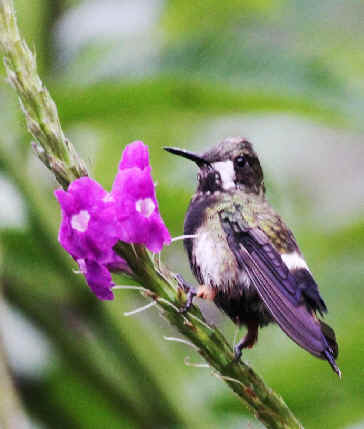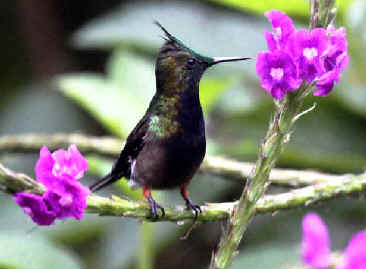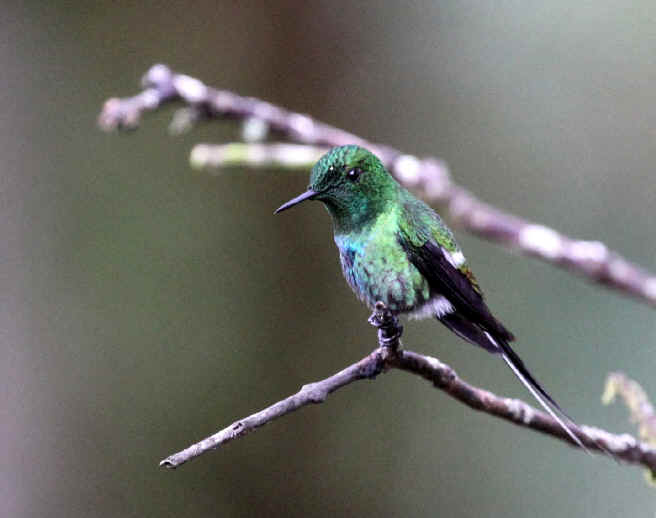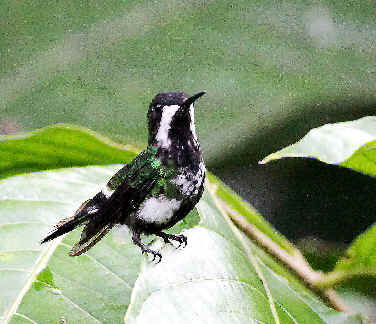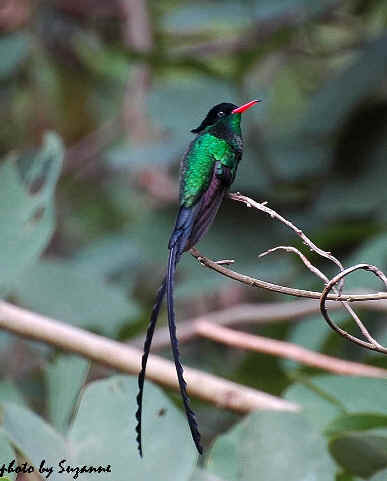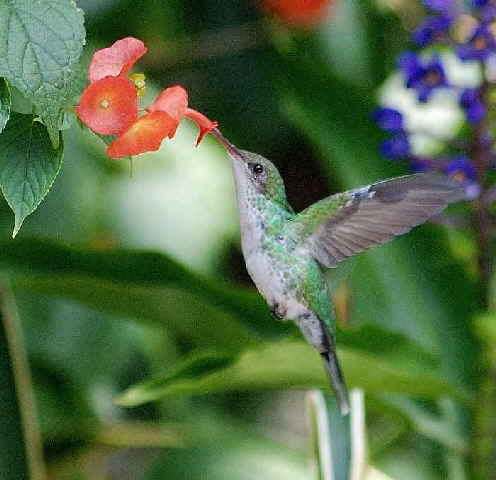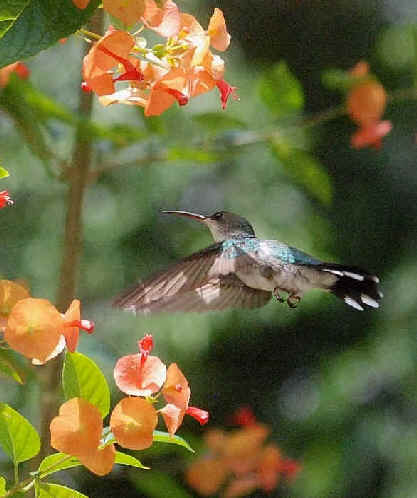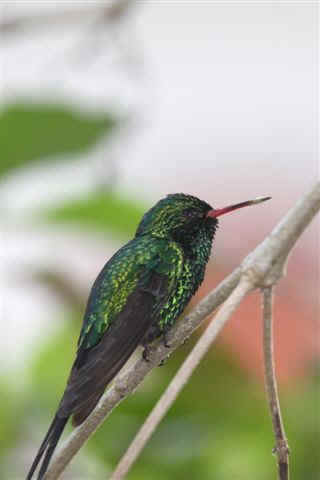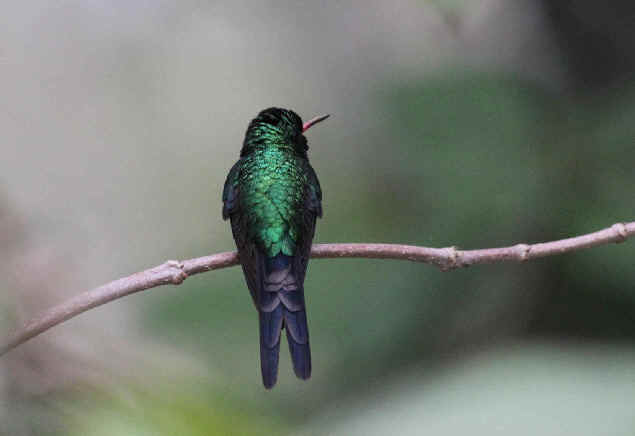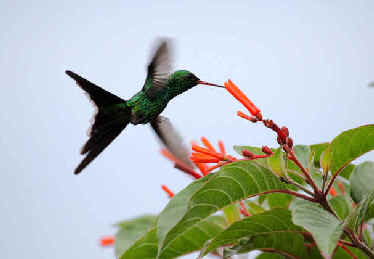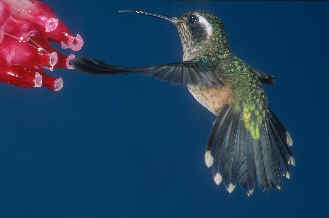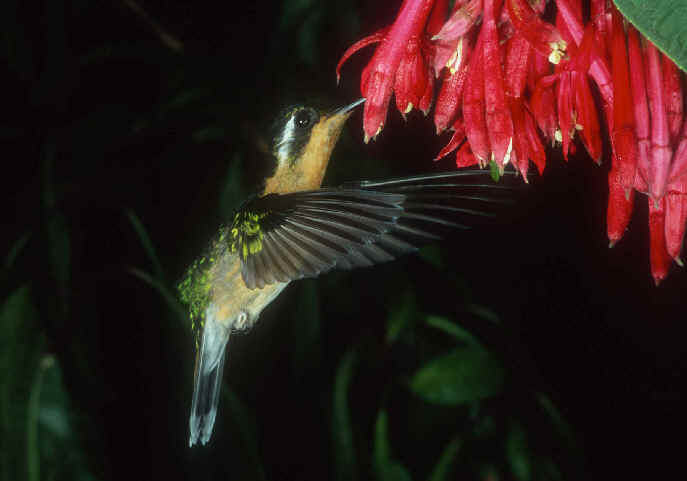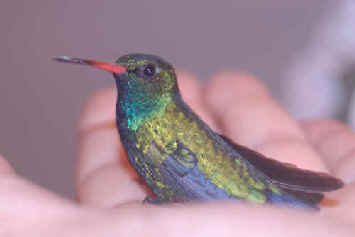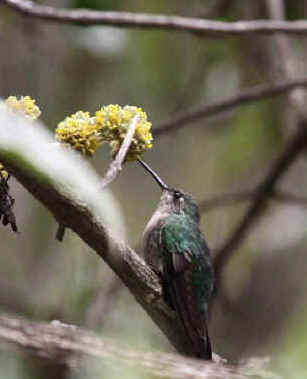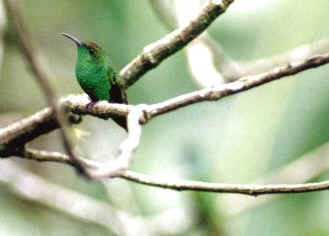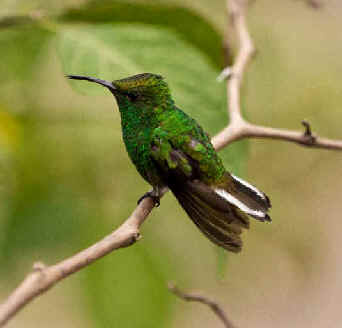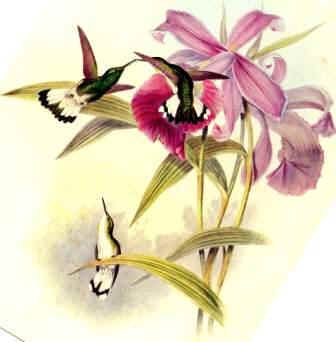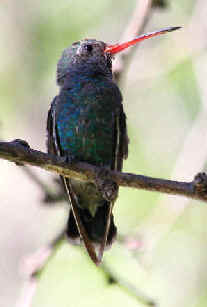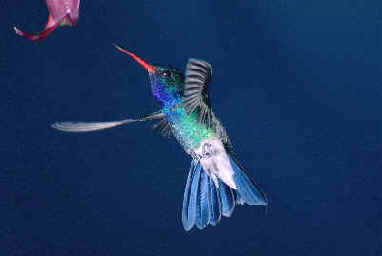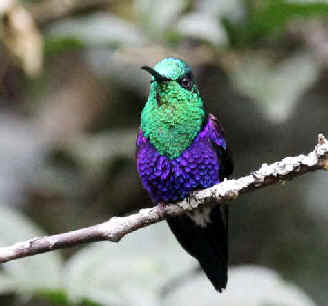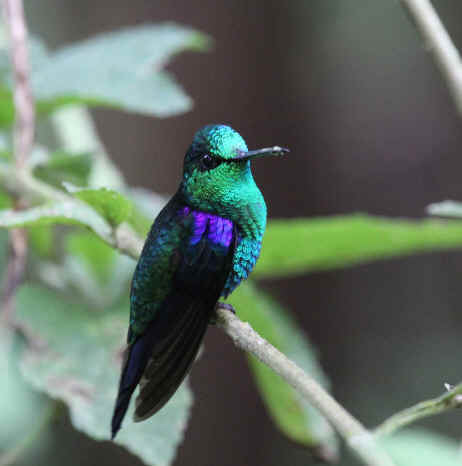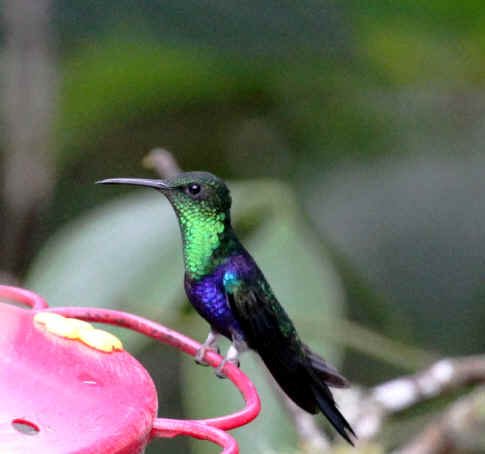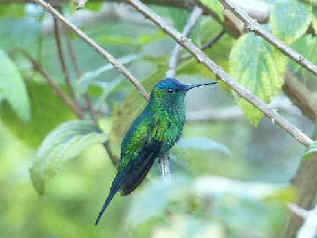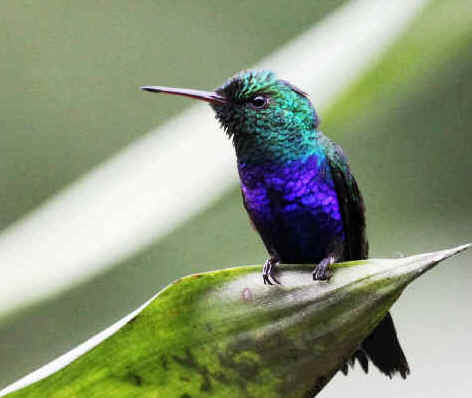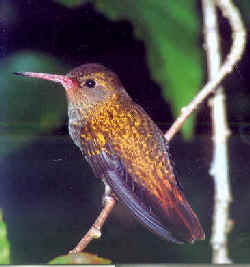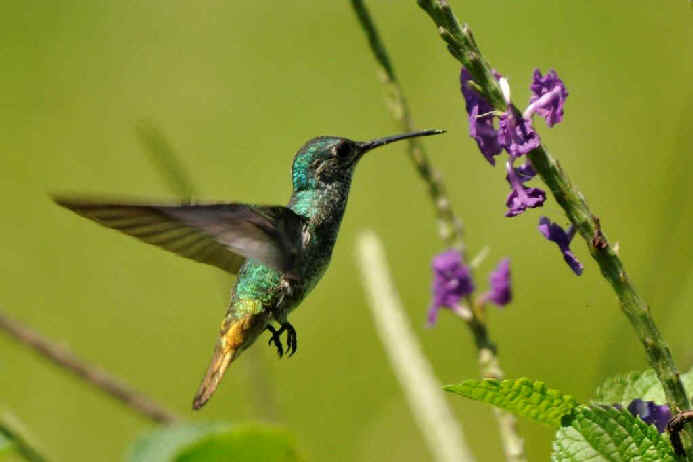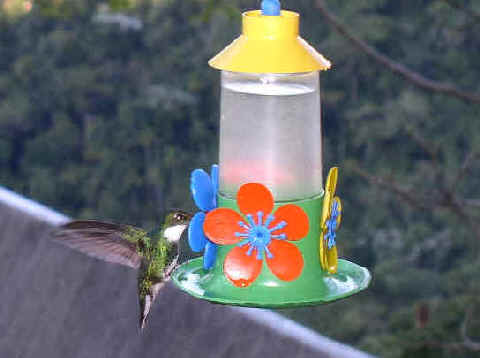 |
PO
Box 9021, Wilmington, DE 19809, USA
E-mail: font@focusonnature.com
Phone: Toll-free in USA 1-888-721-3555
or 302/529-1876
Website:
www.focusonnature.com |
A
List and Photo Gallery
of
Hummingbirds
noting those found during
Focus On Nature Tours
throughout the Americas
Part 1 of a List and Photo Gallery
With
some photos courtesy of our tour participants and others.
Our
thanks to those who have contributed!
Link
to Part 2 of this List & Photo Gallery of Hummingbirds
And
Even More Hummingbird Photos during the Fall of 2012
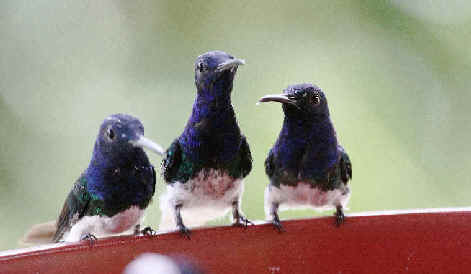
Above
& below: three Jacobins at a feeder
during the April 2014 Ecuador Tour
(photos by Marie Gardner)
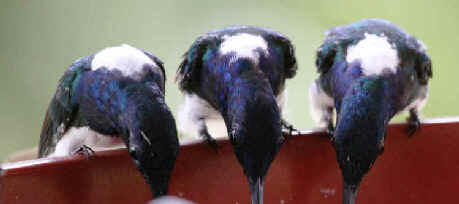
HERE
IN PART 1 OF THIS LIST,
LINKS TO THESE HUMMINGBIRD GROUPINGS:
Euptomena: SWALLOW-TAILED
HUMMINGBIRD
Ramphodon, Glaucis,
Anopetia, Phaethornis: HERMITS
includes
in RAMPHODON: Saw-billed Hermit
includes
in GLAUCIS: Hook-billed Hermit, Rufous-breasted Hermit, Bronzy Hermit
includes in ANOPETIA: Broad-tipped Hermit
includes in PHAETHORNIS: White-whiskered Hermit, Green Hermit,
Tawny-bellied Hermit, Mexican Hermit, Baron's Hermit, Great-billed Hermit,
White-bearded Hermit, Koepcke's Hermit, Needle-billed Hermit, Straight-billed Hermit,
Pale-bellied Hermit, Scale-throated Hermit, Planalto Hermit, Sooty-capped
Hermit,
Buff-bellied Hermit, Dusky-throated Hermit, Streak-throated Hermit, Rupurumi
Hermit,
Minute Hermit, Cinnamon-throated Hermit, Reddish Hermit,
White-browed Hermit, Black-throated Hermit, Little Hermit,
Stripe-throated Hermit, Gray-chinned Hermit
Threnetes: BARBTHROATS
includes Pale-tailed Barbthroat,
Band-tailed Barbthroat
Eutoxeres: SICKLEBILLS
includes White-tipped Scklebill,
Buff-tailed Sicklebill
Androdon: TOOTH-BILLED
HUMMINGBIRD
Doryfera: LANCEBILLS
includes
Green-fronted Lancebill, Blue-fronted Lancebill
Campylopterus: SABREWINGS
includes Violet Sabrewing,
Wedge-tailed Sabrewing,
Long-tailed Sabrewing, Gray-breasted Sabrewing, Rufous Sabrewing,
Rufous-breasted Sabrewing, White-tailed Sabrewing,
Lazuline Sabrewing, Buff-breasted Sabrewing, Napo Sabrewing,
Santa Marta Sabrewing, Scaly-breasted Hummingbird
Aphantochroa: SOMBRE HUMMINGBIRD
Florisuga: JACOBINS
includes Black Jacobin, White-necked Jacobin
Colibri: VIOLETEARS
includes Green Violetear, Brown
Violetear,
Sparkling Violetear, White-vented Violetear
Anthracothorax: MANGOS
includes
Green-breasted Mango, Black-throated Mango,
Veraguan Mango, Green-throated Mango,
Antillean Mango, Green Mango, Jamaican Mango
Avocettula:
FIERY AWLBILL
Topaza, Chrysolampis : TOPAZES
includes
in TOPAZA: Crimson Topaz, Fiery Topaz
includes in CHRYSOLAMPIS: Ruby Topaz
Eulampis: CARIBS
includes:
Purple-throated Carib, Green-throated Carib
Orthorhyncus: ANTILLEAN CRESTED HUMMINGBIRD
Klais: VIOLET-HEADED HUMMINGBIRD
Stephanoxis: PLOVERCREST
Abeillia: EMERALD-CHINNED HUMMINGBIRD
Lophornis: COQUETTES
includes
Tufted Coquette, Dot-eared Coquette, Frilled Coquette,
Short-crested Coquette, Rufous-cresed Coquette, Spangled Coquette,
Festive Coquette, Peacock Coquette, Black-crested Coquette,
White-crested (or Adorable) Coquette
Discosura: THORNTAILS
includes
Wire-crested Thorntail, Black-bellied Thorntail,
Green Thorntail, Coppery Thorntail, Racket-tailed Coquette
Trochilus: STREAMERTAILS
includes
Red-billed Streamertail, Black-billed Streamertail
Chlorostilbon, Elvira: EMERALDS
includes
in CHLOROSTILBON: Cozumel Emerald, Canivet's Emerald,
Salvin's Emerald, Garden Emerald, Golden-crowned Emerald,
(the previous were part of what was the Fork-tailed Enerald),
Blue-tailed Emerald, Western Emerald,
(Western Emerald is split from the Blue-tailed Emerald),
Chiribiquete Emerald, Glittering-bellied Emerald,
Cuban Emerald, Hispaniolan Emerald, Puerto Rican Emerald,
Coppery Emerald, Narrow-tailed Emerald,
Green-tailed Emerald, Short-tailed Emerald
includes in ELVIRA: Copper-headed Emerald, White-tailed
Emerald
Panterpe: FIERY-THROATED HUMMINGBIRD
Eupherusa, Goethalsia, Goldmania, Cyanophaia
includes
in EUPHERUSA: Stripe-tailed Hummingbird, White-tailed Hummingbird,
Black-bellied Hummingbird, Oaxaca Hummingbird
includes in GOETHALSIA: Pirre Hummingbird
includes in GOLDMANIA: Violet-capped Hummingbird
includes in CYANOPHAIA: Blue-headed Hummingbird
Cynanthus: BROAD-BILLED HUMMINGBIRD
Also includes Dusky Hummingbird
Thalurania: WOODNYMPHS
includes
Violet-crowned Woodnymph,
Green-crowned Woodnymph, Emerald-bellied Woodnypmph
(the above 3 have been combined to be Crowned Woodnymph),
Fork-tailed Woodnymph, Violet-capped Woodnymph,
Long-tailed Woodnymph, Mexican Woodnymph
Damophila, Lepidopyga
includes
in DAMOPHILA: Violet-bellied Hummingbird
includes in LEPIDOPYGA: Sapphire-throated Hummingbird,
Sapphire-bellied Hummingbird, Shining-green Hummingbird
Chlorestes,
Hylocharis, Chrysuronia: SAPPHIRES
Leucochloris: WHITE-THROATED HUMMINGBIRD
Polytmus: GOLDENTROATS
Leucippus, Taphrospilus
includes in LEUCIPPUS: Buffy
Hummingbird, Tumbes Hummingbird,
Spot-throated Hummingbird, Olive-spotted Hummingbird
includes in TAPHROSPILUS: Many-spotted Hummingbird
MORE
HUMMINGBIRD GROUPINGS
IN PART 2 OF THIS LIST
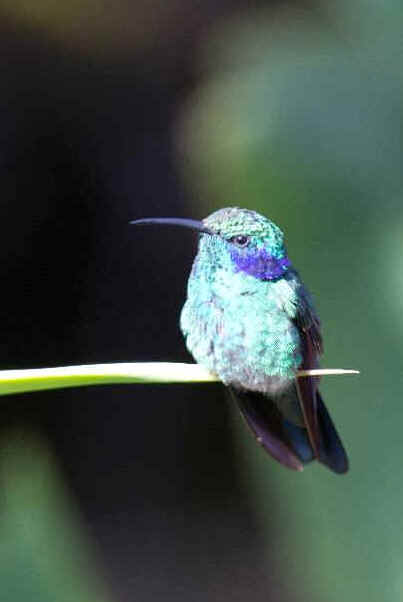
A
Green
Violet-ear photographed during a FONT tour
in Costa Rica in March 2012
(photo by Virginia Woodhouse)
Below are photos of two other hummingbirds we saw in Costa Rica in March
2012,
the Coppery-headed Emerald and the Fiery-throated Hummingbird
Other Links:
FOCUS ON Nature Tours
with hummingbirds, in:
ARIZONA,
USA
CENTRAL
aMERICA
(mexico, BELIZE. guatemala,
costa rica, panamA)
THE
WEST INDIES
SOUTH
AMERICA (BRAZIL & ECUADOR)
SOUTH
AMERICA (ARGENTINA & CHILE)
LISTS & PHOTO GALLERIES
OF BIRDS IN:
North America
Mexico the
Caribbean
Central America
Brazil
Chile Ecuador
FOR MORE ABOUT PLANTS REFERRED TO HERE,
THE LINKS BELOW GO TO LISTS AND PHOTO GALLERIES
WITH PLANTS OF THE TROPICS, AND THE DESERT
Tropical Plants of
Mexico, Central America, South America,
and Caribbean Islands
(in 3 parts, over 1,500 plants)
Desert Plants of the
western US & northern Mexico
(over 850 plants)
Plant Genera in the FONT Website


A List and Photo Gallery of Hummingbirds
compiled by Armas Hill
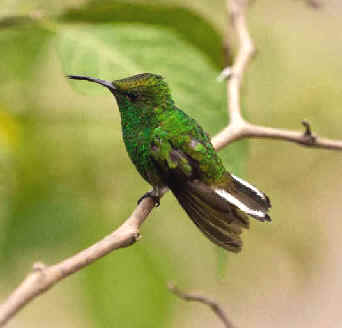 Codes:
Codes:
Places
where Hummingbirds
have been seen during FONT Tours
are noted with an (*)
after the two-letter code
AK: Alaska, US
AR: Argentina, South America
AZ: Arizona, US
BL: Bolivia, South America
BR: Brazil, South America
BZ: Belize, Central America
CA: California, US
CH: Chile, South America
CL: Colombia, South America
CO: Colorado, US
CR: Costa Rica, Central America
DE: Delaware, US
DM: Dominica, West Indies
DR: Dominican Republic, West Indies
EC: Ecuador, South America
FL: Florida, US
GU: Guatemala, Central America
HN: Honduras, Central America
JM: Jamaica, West Indies
MX: Mexico
NC: North Carolina, US
NM: New Mexico, US
PE: Peru, South America
PG: Paraguay, South America
PN: Panama, Central America
PR: Puerto Rico, West Indies
SL: Saint Lucia, West Indies
SV: Saint Vincent, West Indies
TT: Trinidad and Tobago
TX: Texas, US
UG: Uruguay, South America
VE: Venezuela, South America
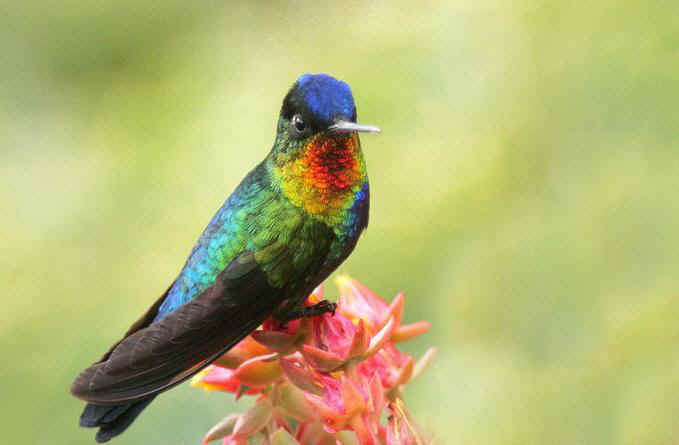
Status of Hummingbirds, as designated by
Birdlife International
(t): a globally threatened, or rare, species
(t1): critical
(t2): endangered
(t3): vulnerable
(nt): a near-threatened species globally
(nt-dd): possibly near-threatened, but data deficient
John Gould, who lived from 1804 to 1881, described many
species and subspecies of hummingbirds. He was one of the most prolific artists
and publishers of ornithological subjects. Nearly 3,000 lithographs were created
during the span of his work.
In this two-part list, species and subspecies of hummingbirds described by Gould
are noted, and there are illustrations of some of his lithographs, of the
Band-tailed Barbthroat, Sombre Hummingbird, White-tailed Emerald, Brazilian
Ruby, and Black-eared Fairy.
EUPETOMENA
- Swallow-tailed Hummingbird _____
BR(*) PG
Eupetomena macroura
SUBSPECIES:
Eupetomena macroura boliviana ______ subspecies
in northwest Bolivia, described in 1959
E. m. boliviana has a green head
Eupetomena macroura cyanoviridis ______ subspecies
in southeast Brazil, described in 1988
Eupetomena macroura hirundo ______ subspecies in
eastern Peru, described by Gould in 1875
E. m. hirundo is more drab and shorter tailed than other
subspecies
Eupetomena macroura macroura ______ subspecies
in the Guianas, Brazil, Paraguay
Eupetomena macroura simoni ______ subspecies in
northeast Brazil
E. m. simoni has a bluer back and belly than other
subspecies
(photo below)
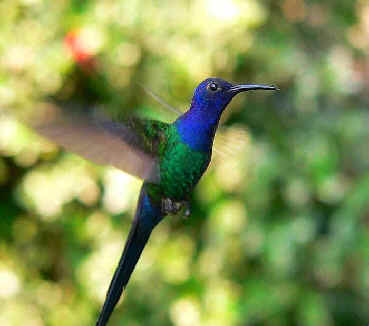
RAMPHODON
- Saw-billed Hermit (nt) ______ BR(*)
Ramphodon naevius
The geographic range of the Saw-billed Hermit is in
southeast Brazil.
The Saw-billed Hermit has a long and rather heavy-looking straight
bill with serrated edges to the mandibles. The bill-tip of the male also has
a small but distinct hook.
The species is a solitary trapline feeder, but an individual can
aggressively challenge and chase other hummingbirds, including other Saw-billed
Hermits, that are encountered along its route.
The Saw-billed Hermit visits flowers with long corollas, and picks
insects from foliage.
(photos below; the lower photo taken during by Marie Gardner
during the March 2008 FONT Brazil Tour )
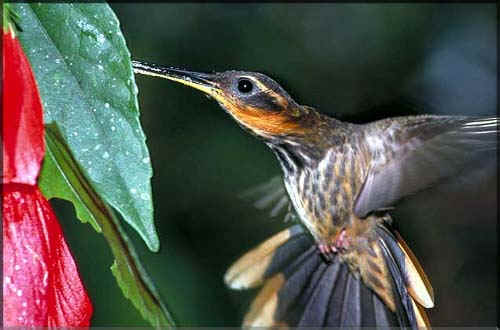
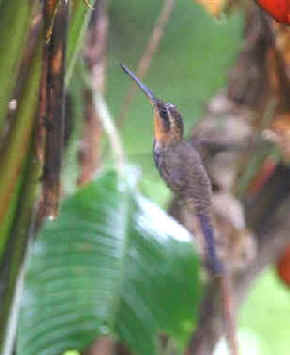
GLAUCIS
- Hook-billed Hermit (t2) ______
BR
Glaucis dohrnii
The geographic range of the Hook-billed Hermit is in southeast
Brazil, recently only in the states of Espirito Santo and Bahia.
The Hook-billed Hermit has a rather straight bill with a small hook
at the tip.
The bird feeds mainly in the forest understory favoring Heliconia
flowers, and like other hermits it is a trapliner.
The Hook-billed Hermit was classified as critically endangered
until 2000, when surveys indicated that it was somewhat more common than had
been supposed.
However, the estimated total population of the Hook-billed Hermit is
very small, probably between 350 and 1,500 individuals, and its population
is fragmented due to widespread habitat loss in the bird's small geographic
range
- Rufous-breasted Hermit ______ BL
BR(*)
EC(*) PE TT VE(*) (has also been
called the Hairy Hermit)
Glaucis hirsutus
SUBSPECIES:
Glaucis hirsutus hirsutus ______ subspecies
from Panama to Bolivia and to the Guianas
Glaucis hirsutus insularum an old name was Trinidad
Hairy Hermit ______ subspecies on
Grenada and Trinidad & Tobago
The subspecies Glaucis hirsutus affinis is no longer valid, now
merged with G. h. hirsutus. It was in Panama.
The Rufous-breasted Hermit eats small spiders and insects, and the
nectar of various flowers, especially Heliconia.
In Ecuador, the Rufous-breasted Hermit occurs up to 3,300 feet above sea
level.
The Rufous-breasted Hermit is closely related to the similar, but
slightly smaller, Bronzy Hermit (below).
- Bronzy Hermit ______ CR(*)
EC
PN(*)
Glaucis aeneus
The geographic range of the Bronzy Hermit is from eastern
Honduras to western Ecuador.
The Bronzy Hermit has sometimes been merged as a single species with
the very-similar Rufous-breasted Hermit (above).
The Bronzy Hermit is typically a trapline feeder, generally feeding
in the understory on insects and small spiders, and on the nectar of various
flowers, especially Heliconia.
In Ecuador, the Bronzy Hermit occurs locally up to 1,800 feet above sea
level.
ANOPETIA
- Broad-tipped Hermit ______ BR(*)
Anopetia gounellei
The geographic range of the Broad-tipped Hermit is in eastern Brazil,
mostly in the states of Bahia, Piaui, and Ceara.
The Broad-tipped Hermit is a fairly small, slenderly-built
bronzy-brown hummingbird. The sexes look the same.
The species is rather uncommon and not well known.
The Broad-tipped Hermit inhabits dense thorny caatinga forest.
Like other hermits, it is a trapliner, working its way around a predictable
circuit from flower to flower when feeding.
PHAETHORNIS
- White-whiskered
Hermit _____ CL EC(*)
(another name was Yaruquian Hermit)
Phaethornis yarugui
Phaethornis yarugui sanctijohannis
is not now recognized as a valid subspecies, as it was an immature bird. It
was called the St. Johanna's Hermit.
The geographic range of the White-whiskered Hermit is in
western Colombia and western Ecuador. In Ecuador, the White-whiskered
Hermit occurs mostly below 3,900 feet above sea level.
(photo below, courtesy of Larry O'Meallie)
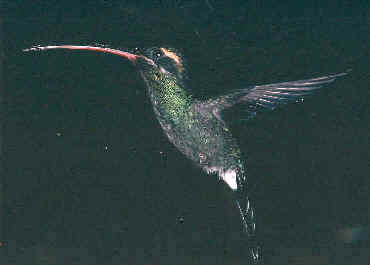
- Green Hermit ______ CL
CR(*)
EC(*) PE PN(*) TT VE(*)
Phaethornis guy
SUBSPECIES:
Phaethornis guy apicalis ______ subspecies from
northern Colombia and northwest Venezuela to southeast Peru
P. g. apicalis is as small as the subspecies emiliae, but with a longer
bill
Phaethornis guy coruscus ______ subspecies in
Costa Rica, Panama, northwest Colombia
P. g. coruscus is the brightest subspecies
Phaethornis guy emiliae ______ subspecies in
west-central Colombia
P. g. emiliae is smaller than the subspecies coruscus and guy, and
with the shortest bill
Phaethornis guy guy an old name was
Guy's Hermit ______ subspecies in
northeastern Venezuela and Trinidad
P. G. guy is larger and darker than the other subspecies
Away from feeders, the Green Hermit feeds in the canopy more than
most hermits. It visits a wide variety of flowers including introduced
species.
Males gather in leks that may contain several dozen individuals, each
delivering its simple repetitive song from within thick shrub.
In Ecuador, the Green Hermit occurs mostly from 2,700 to 5,400 feet above
sea level.
(photo below, by Marie Grenouillet)
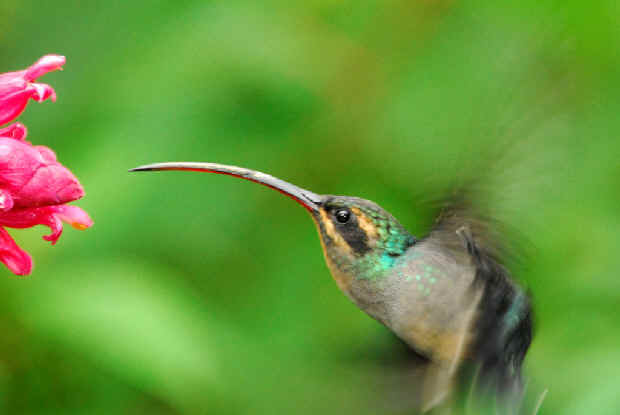
(in the photo below, a Green Hermit resting on a wooden railing of the porch
of a cabin where we stayed during the FONT Ecuador Tour in April 2014.
Hummingbirds are not always so still, or so close.
photo by Marie Gardner)
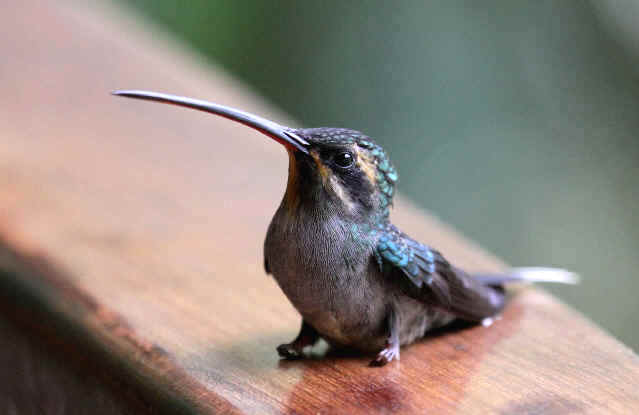
- White-bearded Hermit ______ BR(*)
EC(*) VE(*) (species described by Gould in 1846)
Phaethornis hispidus
The geographic range of the White-bearded Hermit is from
eastern Venezuela to western Brazil and Bolivia. In Ecuador, it occurs below
1,800 feet above sea level.
(photo below, courtesy of Larry O'Mealie)
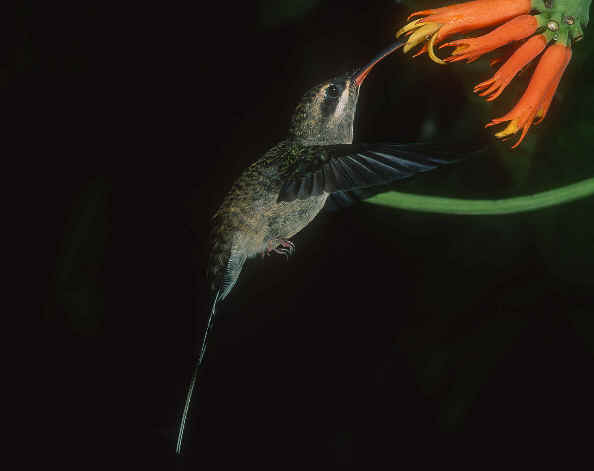
- Long-billed Hermit ______ BZ(*)
CR(*) GU(*) HN(*) MX PN(*)
Phaethornis longirostris
What is now the Long-billed Hermit was part of the Long-tailed
Hermit, Phaethornis superciliosus,
which is now a species only in South America, and it was previously part of
the Great-billed Hermit, also South American.
SUBSPECIES:
Phaethornis longirostris cephalus an old name was
Nicaraguan Long-tailed Hermit ______
subspecies
from eastern Honduras to northwestern Colombia
P. l. cephalus is the brightest subspecies
Phaethornis longirostris griseoventer ______
subspecies in western Mexico
Phaethornis longirostris longirostis an old name was
Guatemalan Long-tailed Hermit ______
subspecies from southern Mexico to northern Honduras
Phaethornis longirostris sussurus an old name was
Buzzing Long-billed Hermit ______
subspecies in northern Colombia
Males of the Long-billed Hermit lek in groups, calling continuously
while pumping their tails.
- Mexican Hermit ______ MX
(has
been part of the Long-billed Hermit, above)
Phaethornis mexicanus
The geographic range of the Mexican Hermit is in southwest Mexico. Phaethornis
mexicanus is larger and darker than Phaethornis
longirostris.
- Baron's Hermit ______ EC(*)
PE
(has been part of the Long-billed Hermit, above)
Phaethornis baroni
The Baron's Hermit is nearly endemic to Ecuador, but
is also in northwest Peru. It occurs mostly below 3,900 feet above sea
level.
- Long-tailed Hermit ______ BR(*)
VE(*) (species described by Linnaeus in 1766)
Phaethornis superciliosus
SUBSPECIES:
Phaethornis superciliosus muelleri
______ subspecies in northern Brazil
Phaethornis superciliosus superciliosus an old name was
Guiana Hermit ______ subspecies
in southern Venezuela, the Guianas, northern Brazil
The Long-tailed Hermit is a trapline feeder, favoring Heliconia
and Passiflora
flowers.
- Great-billed Hermit ______ BL
BR(*) CL
EC(*) PE VE
Phaethornis malaris
SUBSPECIES:
Phaethornis malaris bolivianus an old name was
Bolivian Long-tailed Hermit
______
subspecies in southeastern Peru, Bolivia, western Brazil
Phaethornis malaris insolitus an old name was
Zimmer's Long-tailed Hermit ______
subspecies
in eastern Colombia, southern Venezuela, northern Brazil
Phaethornis malaris malaris an old name was
Nordmann's Long-tailed Hermit ______ subspecies in
the Guianas, northern Brazil
Phaethornis malaris margarettae ______ subspecies
in eastern Brazil, described by Ruschi in 1972
Phaethornis malaris moorei an old name was
Moore's Long-tailed Hermit ______ subspecies
in eastern Colombia, eastern Ecuador, northern Peru
Phaethornis malaris ochrceiventris an
old name was Ochre-vented Long-tailed Hermit
______ subspecies
in northeastern Peru, western Brazil
Most of the above subspecies were part of what was
an expanded Long-tailed Hermit, Phaethornis
superciliosus.
In Ecuador, the Great-billed Hermit occurs mostly below 3,000 feet above sea
level.
- Tawny-bellied
Hermit ______ CL EC(*) PE (species
described by Gould in 1851)
Phaethornis syrmatophorus
SUBSPECIES:
Phaethornis
syrmatophorus columbiansus an
old name was Colombian
Tawny-bellied Hermit
______
subspecies in eastern Colombia, eastern Ecuador, northern Peru; in Ecuador,
on the east slope of the Andes
Phaethornis syrmatophorus syrmatophorus ______
subspecies from western Colombia to southwestern Ecuador; in Ecuador, on
the west slope of the Andes
The subspecies Phaethornis syrmatophorus huallagae, with an old name
of the Peruvian Tawny-bellied Hermit, has been merged with P. s.
columbiansus.
In Ecuador, the Tawny-bellied Hermit occurs mostly from 3,900 to 6,600 feet
above sea level.
(photo below, courtesy of Larry O'Meallie)
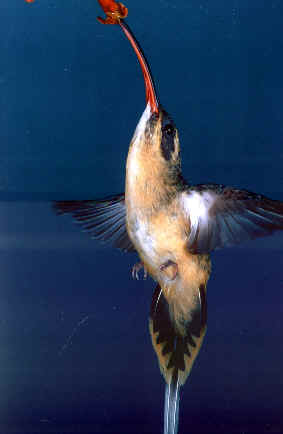
- Koepcke's Hermit (nt) ______
PE (species described in 1977)
Phaethornis koepcheae
The Koepcke's Hermit is endemic to Peru.
- Needle-billed Hermit ______ BL
BR PE
Phaethornis philippii
The geographic range of the Needle-billed Hermit is in eastern
Peru, northern Bolivia, western Brazil.
- Straight-billed Hermit ______ BR
CL
EC(*) PE
VE(*)
Phaethornis bourcieri
SUBSPECIES
Phaethornis bourcieri bourcieri ______
subspecies from eastern Colombia to northeast Peru and Brazil, and to the
Guianas
P. b. bourcieri has two color forms: one with warm brown tones
on the underside, the other grayer
Phaethornis bourcieri major ______ subspecies in
Brazil, described in 1989
P. b. major has only a gray form.
Flowers visited by the Straight-billed Hermit include the tubular
Manettia species, and bromeliads such as Guzmania
and Vriesea. Feeds by traplining,
or circuit-patrolling.
In Ecuador, the Straight-billed Hermit occurs mostly below 2,100 feet above
sea level.
- Pale-bellied Hermit ______ CL
PN VE(*)
Phaethornis anthophilus
SUBSPECIES:
Phaethornis anthophilus anthophilus ______ subspecies
from central Panama to northern Venezuela
Phaethornis anthophilus hyalinus ______
subspecies on Pearl Island in Panama
- Scale-throated Hermit ______ AR(*)
BR(*) PG
Phaethornis eurynome
SUBSPECIES:
Phaethornis eurynome eyrynome ______ subspecies
in southeastern Brazil
Phaethornis eurynome paraguayensis ______
subspecies in eastern Paraguay, northeastern Argentina
- Planalto Hermit ______ AR(*)
BR(*) PG
Phaethornis pretrei
The geographic range of the Planalto Hermit is from
Bolivia, northern Argentina, and Paraguay to eastern
Brazil.
(photo below, taken by Marie
Gardner during a FONT tour in Minas Gerais, Brazil)
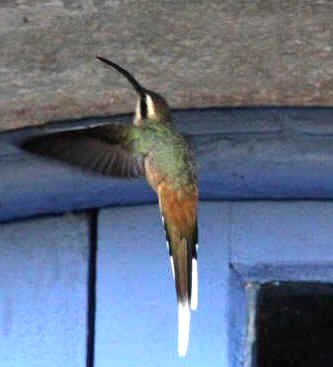
- Sooty-capped Hermit ______ CL
VE(*)
Phaethornis augusti
SUBSPECIES:
Phaethornis augusti augusti ______ subspecies in
eastern Colombia and northern Venezuela
Phaethornis augusti curiosus ______ subspecies
in northern Colombia, described in 1956
Phaethornis augusti incanescens ______ subspecies
in southern Venezuela, western Guyana
- Buff-bellied Hermit ______ BL
BR(*)
Phaethornis subochraceus
The geographic range of the Buff-bellied Hermit is in northern
Bolivia and southern Brazil.
- Dusky-throated Hermit ______ BR(*)
Phaethornis squalidus
The geographic range of the Dusky-throated Hermit is in southeast
Brazil.
- Streak-throated Hermit ______ BR
(was
part of the Dusky-throated Hermit)
Phaethornis rupurmii
SUBSPECIES:
Phaethornis rupurmii amazonicus
______ subspecies around the Amazon River in Brazil
Phaethornis rupurmii rupurmii
______ subspecies in Guyana and nearby area
The geographic range of the Streak-throated Hermit is
north-central Brazil.
Future research may determine that the geographically isolated populations
may be full species.
- Rupurumi Hermit ______ CL
BR VE (was
part of the Streak-throated Hermit)





![]()
 Codes:
Codes:









